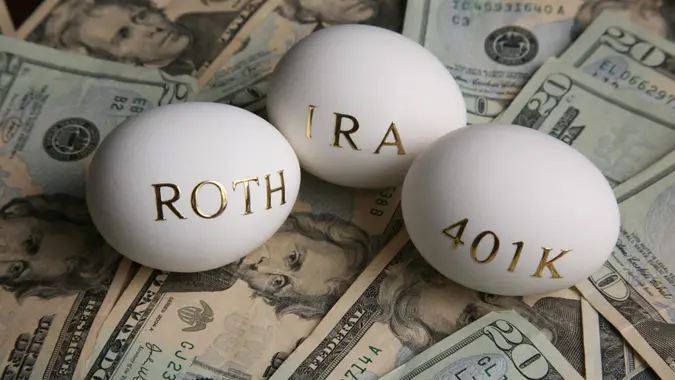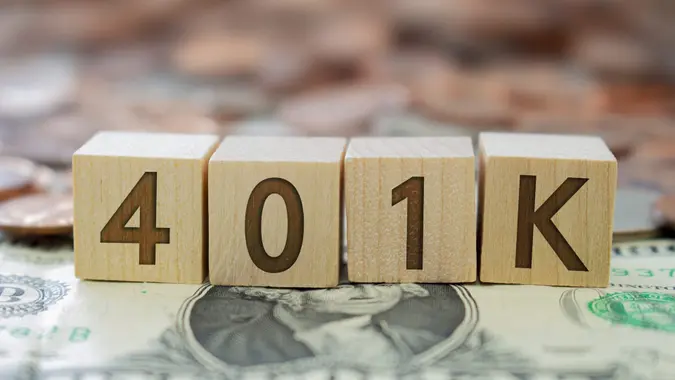How Starting Just 5 Years Earlier Can Make a Huge Difference in Your Nest Egg

Commitment to Our Readers
GOBankingRates' editorial team is committed to bringing you unbiased reviews and information. We use data-driven methodologies to evaluate financial products and services - our reviews and ratings are not influenced by advertisers. You can read more about our editorial guidelines and our products and services review methodology.

20 Years
Helping You Live Richer

Reviewed
by Experts

Trusted by
Millions of Readers
When it comes to investing for retirement, the earlier you can start, the better. The earlier you start, the less you’ll have to contribute to reach your retirement goals. This is due to the amazing power of compound interest. But can starting just five years earlier really make a difference over the 40-year-or-more time frame you’ll be saving for retirement? You might be surprised. Take a look at how the numbers play out below.
What Exactly Is Compound Interest?
Before the math really makes sense, it helps to have an understanding of what compound interest really is.
As defined by the U.S. Securities and Exchange Commission, compound interest is simply the interest you earn on interest. This is the simple reason why compound interest can build up your account value so greatly over time, because you’re earning interest not just on what you invest, but on what you’ve already earned.
Understand, however, that it takes time for compound interest to work its magic. Most of your gains will come in the last years of your plan. In fact, you may not feel like you’re making much progress at all for the first few years that you’re investing. But your compound interest will build up greatly in the final years of a long-term investment plan, providing you with huge gains relative to your initial starting point.
Here’s how compound interest works versus simple interest.
Simple Interest
Simple interest pays you interest on your principal only. It is not compounded. If you have $1,000 in the bank and earn 4% interest per year, you’ll receive $40, no matter how many years you keep your money there.
Compound Interest
Compound interest grows your balance faster because interest is paid on interest you’ve already earned. So in the above example, if you reinvested the $40 you earned on your $1,000, you’d end the year with $1,040. The next year, you’d earn $41.60 in interest, not just $40, and your account value would grow to $1,081.60. The third year, you’d earn $43.26 in interest, and so on. As you can see from the example, earning interest upon interest means you generate more income every single year. Over the long run, this can really add up.
Investing $300 Per Month Starting at Age 30
Imagine a scenario in which you set aside $300 per month and earn an 8% annual return on that money for 35 years. By the time you reach age 65, which is a common retirement age, you’ll have accumulated approximately $688,000 in your account. That’s certainly not a bad start, and a sizable nest egg for many investors. But adding just five years to your time frame can make all the difference in the world.
Investing $300 Per Month Starting at Age 25
If you start your investment plan just five years earlier, at age 25 instead of 30, you can boost your account value by more than 50%. At the same 8% annual return, $300 invested monthly for 40 years, from age 25 to 65, will grow to roughly $1,047,000. It’s true you will have invested an additional $18,000 over those five years, but you’ll end up with an additional $359,000-plus in your account. That’s an amazing tradeoff that’s all due to the power of compound interest.
Understand That Projections Are Just That
The projections above are just that — projections. It’s important to note that it’s all but impossible for your portfolio to earn exactly 8% every single year of your investment plan. In fact, depending on your portfolio allocation, it’s probable that you’ll actually lose money in at least a few years of your decades-long investment career.
This variability of returns can affect the exact amount you accumulate. But if you’re dedicated to maximizing your returns over the years, use down years as an opportunity to add more money to your losing positions. That way, you’ll accumulate more assets at lower prices, and if and when they rebound over time, you’ll generate higher gains.
The bottom line is that regardless of the exact final amounts, one thing is abundantly clear — compound interest can work to your great advantage, and it pays to take advantage of it by investing as early as you can.
 Written by
Written by  Edited by
Edited by 

























